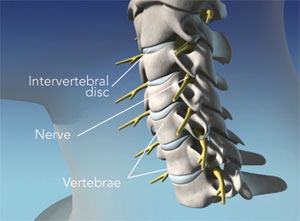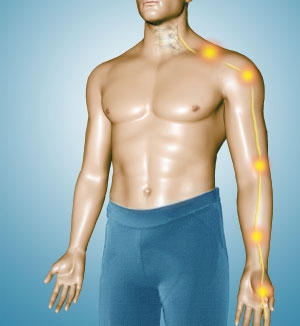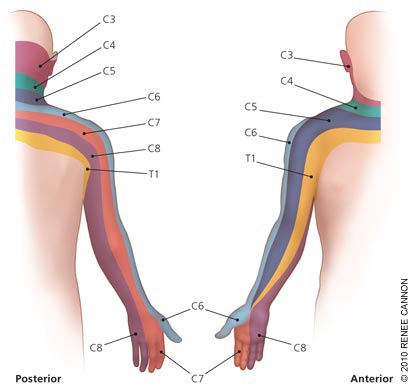YOUR PHYSIO
Condition directory
Cervical Radiculopathy
What is cervical radiculopathy?
Cervical radiculopathy is the technical term for pain caused by irritation of one of the small nerves in the neck. It often causes pain to be felt all the way down the arm and can sometimes be accompanied by pins and needles, and, in rare instances, weakness in the affected arm. It is often called a 'trapped nerve'. The term is often incorrectly applied to neck pain that causes pain to be felt in the muscles at the side of the neck. A true cervical radiculopathy, or trapped nerve, will cause pain that runs down the arm; , the exact site of the arm pain depends on which of the small nerves are involved.

The first diagram shows a 3D model of the bones, discs, and nerves in the neck . As you can see, the nerves (coloured yellow) pass out from inside the neck between the bones, these are called nerve roots and they eventually join together to form three nerves that run down your arm.
Nerves are quite big structures; the second picture gives an artist’s impression of a nerve running from the neck down the arm.

The three nerves that run down your arm are responsible for sensation in different areas of skin and tissue in your arm. Because each of these big nerves is made up from connections made by the nerve roots in the neck we can actually assign different areas of skin to specific nerve roots. When these are mapped out they are called dermatomes. They are pretty similar in everybody.

The multi coloured picture here shows these dermatomes. Each colour represents a different nerve root. They are numbered according to which one of the bones in the neck they are near to (an extra number 8 is added at the bottom, just to confuse things!).
The blue line on the diagram opposite represents the area of skin supplied by the C6 nerve root (the bit of the nerve that exits between the bones in the neck). If this nerve root becomes irritated then usually you will feel pain in the area of the blue line. If your C7 nerve root was irritated you would feel pain in the area of the orange line.
As you can see, with cervical radiculopathy, although the problem is up in the neck, the pain is felt down in the arm; this is called referred pain.
What causes cervical radiculopathy?
As its nickname suggests, for a long time it was thought that the nerve had become 'trapped', usually by a disc ( the cartilage structures that sit between the bones in the neck).
However we know from MRI scans that many people with symptoms of radiculopathy don't having anything pressing or putting pressure on their nerves, and we know from anatomical studies that the discs in the neck tend to be fairly stable structures by our mid 20's meaning that a sudden change to their size or shape is unlikely, unless there has been physical trauma.
What all this means is that, for the majority of people, the physical environment around the nerve is unlikely to be the primary reason they are experiencing pain.
More recent research has indicated that inflammation, in the vicinity of the nerve root, (either from one of the small joints, connective tissues, or muscles) is a likely trigger for radiculopathy. Inflammation causes a build up of chemicals associated with healing which result in a change in the acidity of soft tissues. This change in acidity can cause a consequential swelling response in a nerve root, making it sensitive to movement, causing pain.
What treatment is available?
If your symptoms have just begun they are likely to settle fully within 6-12 weeks.
As we have shown, there is often an inflammatory cause for the pain you are experiencing, so taking a course of non-steroidal anti-inflammatory (NSAID's) tablets may be helpful. Although these are available over the counter at your local pharmacist, we would always recommend checking with the Pharmacist that this medication is suitable for you. Additionally, if your pain is severe, you may want to speak to your GP about pain relief specifically for nerve pain.
Exercises can be helpful in resolving an episode of cervical radiculopathy. We advise trying to maintain mobility in your neck and in the nerves down your arm.
The following mobility exercise can be useful.
Physiotherapy is often very beneficial for cervical radiculopathy and things usually improve quite quickly with a course treatment. If your symptoms are not improving with advice and medication, speak to your GP about a referral to the MSK service or fill out our self referral form here.